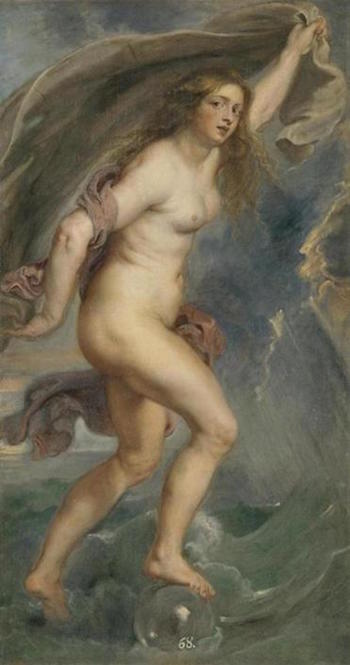Visual Arts Review: “Splendor, Myth, and Vision: Nudes from the Prado”
Beyond a few superb works, the panorama of flesh proves to be oddly enervating.
Splendor, Myth, and Vision: Nudes from the Prado, at the Clark Art Institute, Williamstown, MA, through October 10.

Excerpt from “Venus with Organist and Cupid,’ by Titian (1550-55), oil on canvas. Photo: courtesy of the Clark Art Museum and Museo Nacional del Prado.
By Charles Giuliano
While the Clark Art Institute was closed for construction it organized a global tour from its holdings. In 2010-11 there was a blockbuster show of 31 works by Renoir (from the Clark’s collection) at the Prado Museum in Madrid.
Following the quid pro quo of museum trades, the Williamstown museum is hosting “Splendor, Myth, and Vision: Nudes From the Prado,” which includes 28 paintings by primarily Italian, Flemish, and Spanish masters of the 16th and 17th centuries.
Beyond a few superb works, the panorama of flesh proves to be oddly enervating.
The archaic Greek Kouros figures of nude athletic youth created the paradigm of male beauty that prevails even today. The Kore or female ideal, however, changes constantly.
This disparity is evident in the exhibition. The women depicted in mythological works inspired by ut pictura poesis are corpulent by contemporary standards. The male figures, from images of Hercules to the martyr St. Sebastian, are easier on the eye.
In conservative Catholic Spain and its Inquisition the monarchs assembled art collections of great depth, gathering nudes by Titian, Rubens, and other Renaissance and Baroque masters.
When Philip III [1578-1621] came to power he moved the nudes from prominent view and contemplated having them destroyed. They survived but were sequestered in Sala Reservada. This prevailed during the early years of the Prado Museum.

“Fortuna” by Peter Paul Rubens (1636-38), oil on canvas. Photo: courtesy of the Clark Art Museum and Museo Nacional del Prado.
As you enter the exhibition, flanking Peter Paul Rubens’ “Fortuna” and its superb female standing figure, are portraits of the Spanish monarchs Philip II (by Titian) and Philip IV (by Diego Velasquez). These sensitive and absorbing portraits are among the gems of the exhibition.
The second gallery, an alcove, displays the masterpiece “Venus with an Organist and Cupid” (c. 1550-55). It is one of five works that Titian created on this theme. By this time, the Venetian master had perfected the technique of applying layers of glaze over brighter underpainting. The result is flesh that glows with a delicious luminosity.
In the manner of the time, the goddess is full figured and dimpled. By our standards she is overly abundant in hips and abdomen while the breasts are modest. Her face, however, is ravishingly exquisite. A string of pearls suggests she has emerged from the sea in a giant scallop shell. Other iconic references include a satyr fountain and strolling lovers. The musician playing an organ turns and gazes directly at her genitalia. She, however, is distracted by Cupid.
Rubens was a frequent traveler, an ersatz aesthetic ambassador. He visited the Spanish court in 1603-04 and returned in 1628-29. He was commissioned to create 60 works based on Ovid’s Metamorphoses, and in the process made copies of a number of Titians. At the Clark, there is a stunning and fairly exact rendering of the “Rape of Europa,” which can be found at Boston’s Gardner Museum. It is fascinating to study the copy and see how closely it resembles the original.
Aside from these highlights, most of the works in the show are pedestrian. There are, however, some pleasant surprises, including a soft and moody “Lot and His Daughters” by Francesco Furini. The single French picture here — Poussin’s “Bacchic Scene” — is a fascinating curiosity.
Charles Giuliano, founder/publisher of www.berkshirefinearts.com, is an art historian and former writer/critic/editor for Art New England, The Boston Herald Traveler, Boston After Dark, The Avatar, and The Patriot Ledger. He taught at New England School of Art at Suffolk University, Boston University, Salem State University, UMass Lowell and Clark University.
Tagged: Charles Giuliano, Museo Nacional del Prado, Nudes from the Prado
